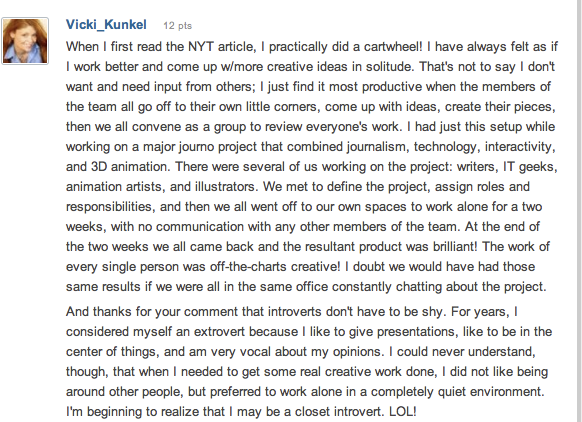 I had a really interesting experience last week.
I had a really interesting experience last week.
This may not be new to some of you, but it was new to me…and it was really freaking cool!
I was invited to participate in a think tank for Interlochen, a center for the arts in Traverse City, Mich.
More on them in a minute.
They invited four experts to join four staff and two board trustees in a day of thinking, brainstorming, cajoling, and planning.
With the New York Times article about how Groupthink and brainstorming don’t work on my mind, I was interested to see how this all played out.
Was it going to work?
The Charrettes
About 10 days before the think tank meeting, we each received a package from the Interlochen team. It included their annual report, some collateral pieces, and a 12 page document that described their story, their SWOT analysis, the work they’ve already done, and their vision and goals for the future.
At the end of the document was the agenda and our assignment: To create a 15-20 minute charrette and be ready to present it during the meeting.
What’s a charrette, you ask? According to Wikipedia:
A charrette is a method of organizing thoughts from experts and the users into a structured medium that is unrestricted and conducive to the creativity and the development of myriad scenarios.
Put more simply, it’s a way for a group of people to get together and brainstorm with structure. It’s a way to be sure even the introverts have a voice. And it’s a way to be sure not one person does all the talking and is the only voice who gets a say.
The meeting was divided by charrette. You had 15-20 minutes to present your thinking and then debate its merits with the other experts, staff, and trustees.
It worked really, really well. Better than any brainstorm I’ve ever sat in on. It reminded me of how Vicki Kunkel says she collaborates with others.
For those of you in charge of creating brainstorm meetings at work, I highly recommend this method. It takes a little more upfront work, but the ideas, creativity, and innovation you’ll get in return will be a great return on your time.
About Interlochen
The other reason I felt the day was so fruitful is I was exposed to an organization in an industry I don’t often work.
You see, I danced all the way through college. I even thought I was going to be a prima ballerina. But then I found out how much (or little) they make and that made up my mind for me.
But the kids who attend either summer camp or the boarding high school academy don’t care how little money they make. They are there for their art and that’s all that matters in the world. These are the kids who end up going to Juilliard or one of the other arts colleges.
I was really, really impressed both with the organization and the work they are doing to advance arts into the 21st Century.
There are a lot of lessons corporations can take from watching organizations like Interlochen.
For me? I walked away last Friday with some distance learning ideas for Spin Sucks Pro and a couple of really innovative things that may change the way we service our clients and write this blog.
Special thanks to Leggitt Studio for the best image I could find on what it looks like to work together in a charrette setting.
